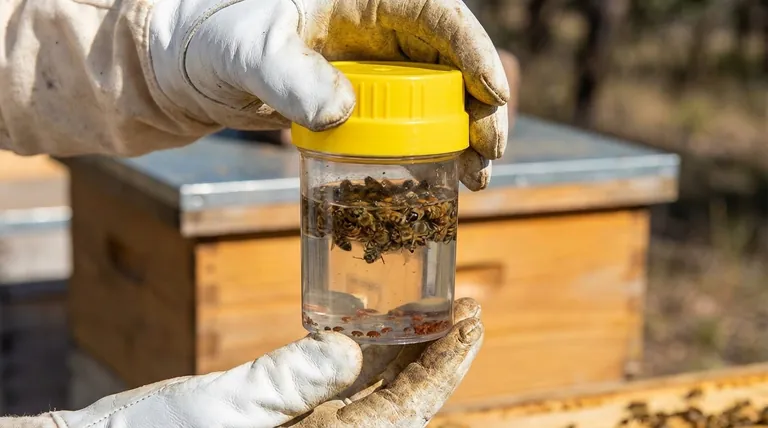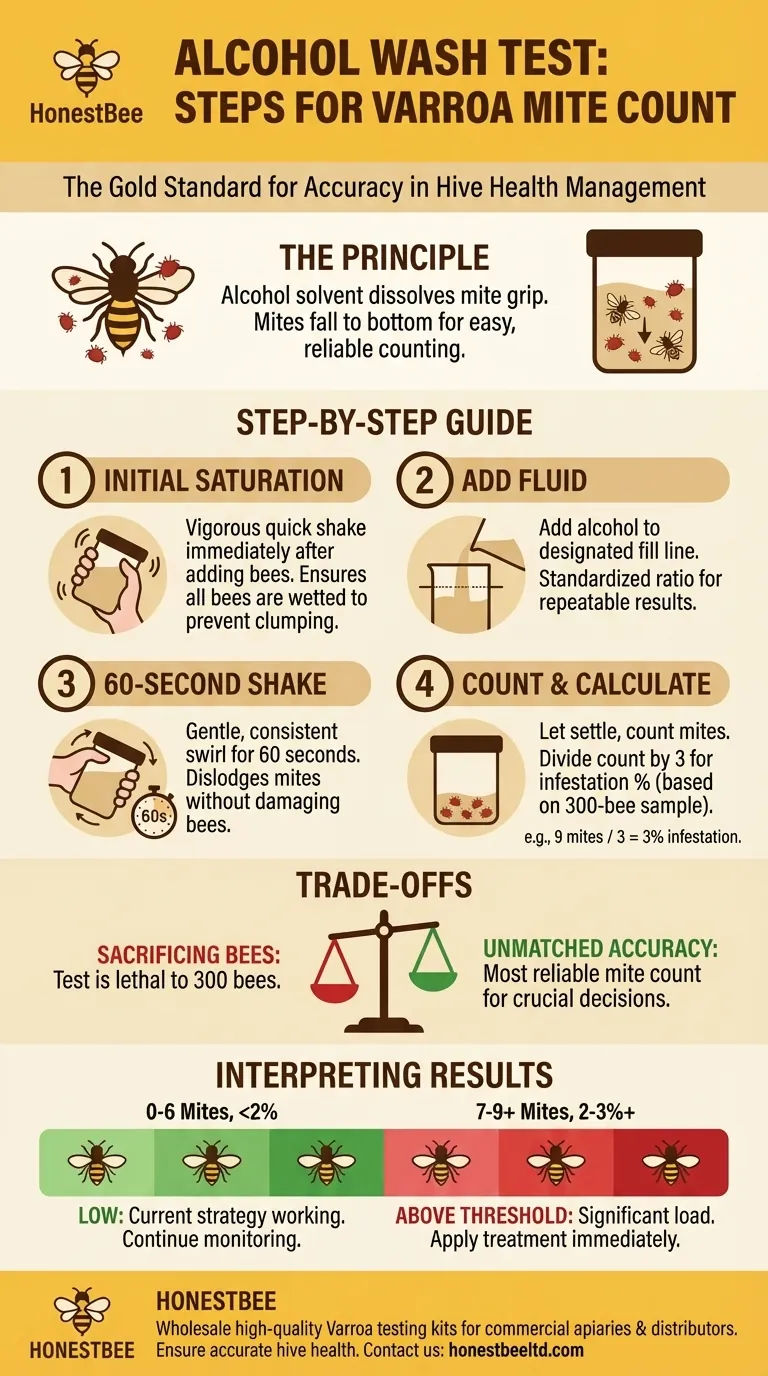Once you have collected your bee sample, the alcohol wash test itself is a straightforward process to get an accurate Varroa mite count. The key steps involve agitating the bees in alcohol for a specific duration to dislodge the mites, allowing them to settle for an easy count, and then calculating your infestation level. This process provides the most reliable data for making critical hive management decisions.
The alcohol wash is the gold standard for Varroa mite testing because of its accuracy. While it requires sacrificing a small portion of the colony (typically 300 bees), the reliable data it provides is essential for determining if and when treatment is necessary to protect the entire hive.

The Principle Behind the Alcohol Wash
An alcohol wash works by using a solvent—typically rubbing alcohol or winter-grade windshield washer fluid—to dissolve the grip Varroa mites have on a bee's body.
The mites fall from the bees and sink to the bottom of the container, where they can be easily counted. This direct counting method is more accurate than alternatives like the sugar shake, where some mites may remain attached to the bees.
Step-by-Step Guide to an Accurate Wash
The precision of your results depends on a consistent and repeatable process. Follow these steps after you have already collected your half-cup (approximately 300) bee sample.
Step 1: Initial Saturation
Immediately after adding your bees to the testing container, give it a quick, vigorous shake.
This initial agitation ensures all bees are thoroughly wetted with the alcohol, preventing them from clumping together and trapping mites, which would lead to an inaccurate count.
Step 2: Add the Correct Volume of Fluid
If you have not already, add your alcohol-based fluid to the designated fill line on the outer container. For most commercial testers, this is the upper line.
Using a consistent volume of fluid ensures a standardized ratio of bees to liquid, which is critical for achieving repeatable results across multiple hives and testing dates.
Step 3: The Critical 60-Second Shake
With the lid sealed, shake the container gently but consistently for a full 60 seconds.
A gentle, swirling agitation is sufficient. The goal is to create enough motion to dislodge the mites without breaking up the bees' bodies, which can create debris and make counting difficult. Sixty seconds is the industry-standard duration to ensure maximum mite release.
Step 4: Counting and Interpretation
After shaking, let the container sit for a moment to allow the mites to settle. Count the small, reddish-brown mites that have collected at the bottom of the transparent outer container.
To find your infestation percentage, simply divide this mite count by 3. This calculation assumes you started with a standard 300-bee sample (as 100 is one-third of 300). For example, finding 9 mites means you have a 3% infestation rate (9 / 3 = 3).
Understanding the Trade-offs
No method is perfect. Understanding the pros and cons of the alcohol wash allows you to use it effectively as a management tool.
The Primary Drawback: Sacrificing Bees
This test is lethal to the bee sample. For many beekeepers, this is a significant emotional and practical consideration.
However, a healthy, populous colony in summer can lose over 1,000 bees per day naturally. The sacrifice of 300 bees is a small but necessary price to pay for the data needed to protect the other 50,000+ bees in the hive.
The Unmatched Benefit: Accuracy
The reason the alcohol wash is the preferred method for researchers and serious beekeepers is its reliability. It consistently provides the most accurate snapshot of the mite load within a hive.
Inaccurate tests can give you a false sense of security, leading you to delay treatment until the mite population has exploded and the colony is in serious jeopardy.
A Note on Reusing Fluid
The reference material mentions you can filter the alcohol through a fine mesh or coffee filter to reuse it for future tests. This is a practical way to conserve resources.
Be aware that after several uses, the fluid can become saturated with bee debris and alarm pheromones, potentially reducing its effectiveness and making mite counting more difficult. Replace it when it becomes visibly cloudy.
Interpreting Your Results for Action
Your mite count is not just a number; it is a direct signal from your hive that dictates your next steps. Economic thresholds for treatment can vary by season and region, but general guidelines are effective.
- If your mite count is low (e.g., 0-6 mites, or <2%): Your current mite management strategy is working. Continue monitoring regularly (e.g., monthly) but immediate treatment is likely not required.
- If your mite count is at or above the treatment threshold (e.g., 7-9+ mites, or 2-3%+): The hive has a significant mite load that requires intervention. This result is a clear signal to apply a Varroa treatment to prevent the colony from being overwhelmed.
This simple, accurate test is your most powerful tool for proactive hive health management.
Summary Table:
| Step | Key Action | Purpose |
|---|---|---|
| 1 | Initial Saturation & Shake | Wet all bees to prevent clumping and trapped mites |
| 2 | Add Fluid to Fill Line | Standardize bee-to-liquid ratio for repeatable results |
| 3 | Shake for 60 Seconds | Dislodge mites without breaking bee bodies |
| 4 | Count Mites & Calculate % | Divide mite count by 3 (for 300-bee sample) to get infestation rate |
Need reliable equipment for precise Varroa mite testing? As HONESTBEE, we supply commercial apiaries and beekeeping equipment distributors with high-quality, wholesale-focused testing kits and supplies. Our durable alcohol wash containers and accessories are designed for accurate, repeatable results—helping you protect your hives with confidence. Contact our team today to discuss your bulk supply needs and ensure your operation has the tools for proactive hive health management.
Visual Guide

Related Products
- Varroa Easy Check Mite Tester Kit Counter Alcohol Wash Jar
- Nicot Queen Rearing Kit for Beekeeping and Grafting in Nicot System
- Professional Plastic Queen Excluder for Modern Beekeeping
- Jenter Queen Rearing Kit Complete Set for Bee Breeding
- Langstroth Screen Bottom Board for Beekeeping Wholesale
People Also Ask
- Why is an alcohol wash preferred over powdered sugar rolls? For Accurate Varroa Mite Management
- How often should varroa mite checks be performed using the alcohol wash method? Optimize Your Apiary's Health
- How is the infestation percentage calculated after counting mites? Master Varroa Mite Monitoring
- How does the Varroa EasyCheck determine mite counts? Achieve Accurate Hive Health Monitoring
- What is the most accurate method for monitoring varroa mites? The Definitive Guide for Beekeepers



















